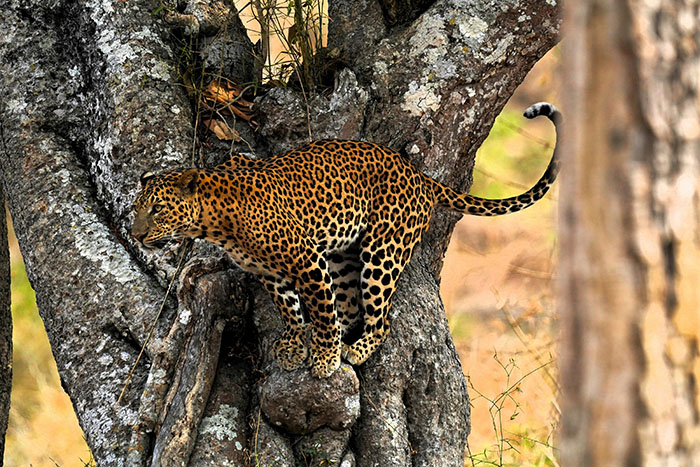Ranthambore National Park, located in the Sawai Madhopur district of Rajasthan, is one of the most famous national parks in India. Known for its rich biodiversity and iconic tiger population, Ranthambore offers visitors an unforgettable wildlife safari experience amidst historical ruins and scenic landscapes. Here’s an overview of Ranthambore National Park:
Location: Ranthambore National Park is situated in the eastern part of Rajasthan, approximately 130 kilometers (80 miles) from the capital city of Jaipur. It covers an area of around 392 square kilometers (151 square miles) and is part of the larger Ranthambore Tiger Reserve.
Biodiversity: The park is characterized by dry deciduous forests, open grasslands, and numerous water bodies, including lakes and streams. Ranthambore is renowned for its population of Bengal tigers, which roam freely in their natural habitat. Apart from tigers, the park is also home to leopards, sloth bears, striped hyenas, sambar deer, chital (spotted deer), nilgai (blue bull), and over 300 species of birds.
Historical Significance: Within Ranthambore National Park, ancient remnants dot the landscape, with the imposing Ranthambore Fort standing as a testament to its rich history dating back to the 10th century. Commanding a panoramic view of the park, this fortification not only holds historical significance but also enhances the park’s natural splendor, further elevating Ranthambore as an irresistible draw for tourists seeking both cultural and natural marvels.
Conservation: Ranthambore National Park plays a crucial role in tiger conservation efforts in India and is considered one of the success stories of tiger conservation. Conservation initiatives within the park focus on habitat protection, anti-poaching measures, scientific research, and community engagement to ensure the long-term survival of the tiger population and other wildlife species.
Accessibility: The gateway to Ranthambore National Park, Jaipur International Airport, sits about 180 kilometers (112 miles) distant, facilitating easy access for visitors. Ground transportation options abound, with frequent bus and taxi services linking Jaipur and neighboring cities to the park’s doorstep. For those opting for rail travel, Sawai Madhopur Railway Station stands as the closest hub, a mere 11 kilometers (7 miles) away, serving as a convenient transit point for adventurers venturing into the wilds of Ranthambore.


Embarking on a safari adventure in Ranthambore National Park promises an exhilarating journey, immersing you in the untamed beauty of nature and providing unparalleled encounters with magnificent wildlife. Here’s your essential guide to orchestrating a memorable safari experience in Ranthambore:
1. Safari Zones: Ranthambore National Park is partitioned into several safari zones, each boasting distinct landscapes and wildlife encounters. Spanning from Zone 1 to Zone 10, these areas offer diverse habitats and opportunities for exploration. Notably, Zone 1 stands out as the favored spot for glimpsing majestic tigers in their natural habitat. It’s important to note that the allocation of safari zones is at the discretion of park authorities, ensuring a fair and varied experience for all visitors, with the safari route determined accordingly.
2. Types of Safaris: There are two types of safaris available in Ranthambore National Park:
- Jeep Safari: For those seeking a more personalized wildlife encounter, jeep safaris prove ideal, catering to small groups or families. With limited passenger capacity per jeep, these excursions provide ample opportunities for enhanced wildlife viewing and photography, ensuring an intimate and immersive experience amidst nature’s wonders.
- Canter Safari: Larger groups or budget-conscious travelers may opt for canter safaris, characterized by their spacious, open-air vehicles. While offering a broader field of vision, canter safaris may lack the intimacy of jeep excursions. Nevertheless, they remain a practical choice for accommodating larger groups while still enjoying the thrill of wildlife exploration in Ranthambore National Park.
3. Safari Timings: Ranthambore National Park operates two safari slots daily, one in the morning and another in the afternoon. Timing variations may occur depending on the season, with morning safaris typically commencing at the break of dawn to capitalize on prime wildlife activity, while afternoon safaris extend into the late afternoon, allowing ample time to bask in the golden hues of the sunset amidst the park’s wilderness.
4. Booking Safari Permits: It’s essential to book safari permits in advance, as the number of vehicles allowed inside the park is limited. Permits can be booked online through the official website of the Rajasthan Forest Department or authorized tour operators and travel agencies. It’s advisable to book permits well in advance, especially during the peak tourist season.
5. Safari Essentials: Before embarking on your safari adventure in Ranthambore National Park, ensure you pack the following essentials:
- Binoculars and camera gear for wildlife viewing and photography.
- Sunscreen, hats, and sunglasses to protect against the sun.
- Light snacks and water to stay hydrated during the safari.
- Comfortable clothing and sturdy shoes are suitable for outdoor activities.
6. Wildlife Etiquette: While on safari, it’s essential to follow the park rules and guidelines to ensure the safety of both visitors and wildlife. Maintain a respectful distance from the animals, refrain from making loud noises or sudden movements, and avoid littering or disturbing the natural environment.
7. Hiring a Guide: Consider hiring a knowledgeable guide or naturalist to accompany you during the safari. Local guides are familiar with the park’s terrain and wildlife behavior, enhancing your safari experience with their insights and expertise.
By planning and adhering to park regulations, you can enjoy a memorable safari experience in Ranthambore National Park, immersing yourself in the breathtaking beauty of nature and encountering iconic wildlife species like the Bengal tiger in their natural habitat.
Ranthambore National Park presents an extraordinary wildlife safari adventure, seamlessly blending the excitement of encountering majestic tigers with the allure of ancient heritage. This harmonious fusion makes it an essential destination for nature aficionados and wildlife devotees seeking unforgettable experiences in the heart of nature’s embrace.


